How much does it cost to create an online marketplace like eBay, Etsy, or Amazon? There are numerous attempts to estimate the cost of building similar platforms online but the fact is, the exact number is known only to the owners.
Instead, this post focuses on real-life B2C marketplace projects that the Syndicode team has worked on. Thus, you’ll have actual numbers for reference in your own project estimates. Plus, after reading this guide, you’ll have a framework for estimating your project’s cost independently.
To set your expectations and ensure you’re in the right place, here are a few points about this post. Firstly, we’ll touch on pre-made solutions, but our focus will mainly be on custom development. Secondly, our information is geared towards the European and US markets due to our company’s background.
Lastly, if you’re new to app development for the marketplace industry, we recommend reading our guide to the marketplace development process. This way, you’ll have all the necessary basics before delving into learning how much it costs to develop a marketplace app.
Now, let’s look at rough estimates for marketplace website development costs based on project scope:
- Small marketplace project (a basic online platform for buying and selling a single type of product or service): $100,000–125,000;
- Medium-complexity project (a platform for buying and selling a variety of products from different sellers): $140,000–200,000;
- Complex marketplace (having advanced features and potentially cutting-edge technologies): starting at $350,000.
These figures are approximations, and marketplace projects have no formal categorization. Use them as reference points to gauge the kind of functionality you might expect within your budget.
Factors affecting marketplace development costs
When inquiring about how much it costs to build a marketplace website from scratch, keep these points in mind:
- No initial estimate can be precise. The cost of building an online marketplace depends on project details, clarified during the discovery session. In custom development, building something is often necessary to determine requirements and make more accurate estimates.
- Cost isn’t the most critical factor when choosing an IT vendor. Efficient development processes and clear communication tend to be more cost-effective in the long run than opting for a cheaper option.
- Software development is a creative process, and there isn’t always a single correct way to implement functionality. Different teams may choose varying approaches, impacting the final cost differently.
The Cone of Uncertainty concept illustrates how precision is linked to research and planning:
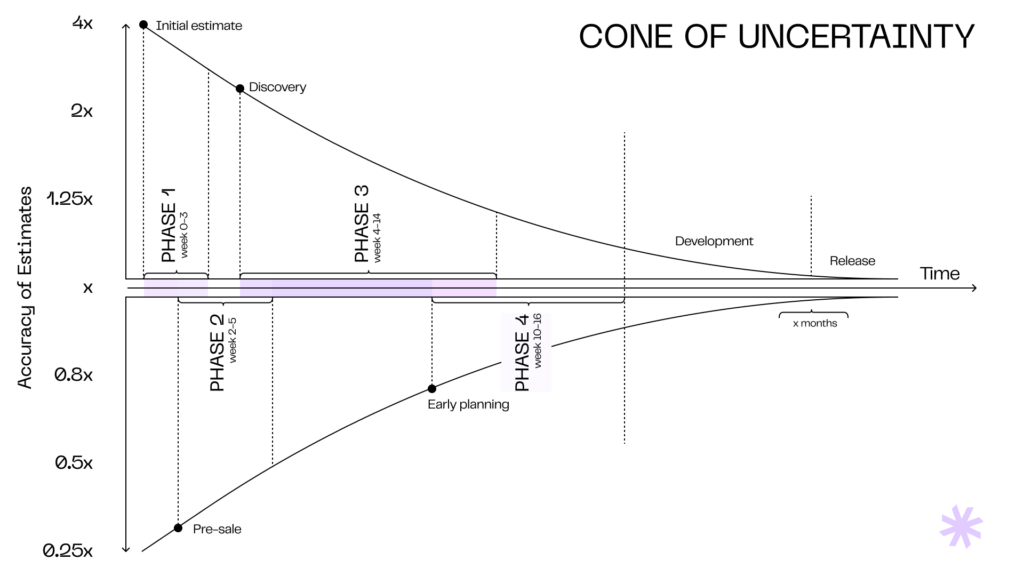
In addition, several other factors contribute to determining how much it costs to build an online marketplace, including:
- Marketplace type;
- Project scope;
- Technology stack;
- Design complexity;
- Project management approach;
- Engagement model;
- Customization.
Now, let’s delve into these factors in more detail.
Want a custom revenue-bringing marketplace?
Contact us to discuss your idea and come up with a unique solution
Contact usTypes of online marketplaces
The type you choose shapes how you go about building an online marketplace. Different marketplace types come with unique features, functionalities, and complexities.
These factors impact the resources, time, and expertise needed for development, influencing the overall marketplace website development cost. Typically, marketplaces are categorized based on participants and business models.
Marketplace classification by participants
Depending on your target audience and the intended seller-buyer relationship, your marketplace can fall into one of the following categories:
- B2B marketplaces sell products or services in bulk and are often operated by a third party. To determine how much it costs to build a B2B marketplace website, you must factor in such features as managing complex order processes, custom pricing, and seamless communication between businesses. Examples include Alibaba and eWorldTrade.
- B2C marketplaces offer businesses a chance to sell directly to customers. They focus on creating easy-to-use interfaces, secure payment gateways, and effective product listing and search functions. Examples include AliExpress, Booking.com, and Bonanza.
- P2P or C2C marketplaces connect individuals to share products and services for money or other items. Key features that determine the cost of developing a peer-to-peer marketplace include user-friendly listings, secure payment systems, and practical communication tools for buyers and sellers. Etsy, Uber, and BlaBlaCar are examples.
- eCommerce marketplaces allow both businesses and individuals to sell their products and services to a wide range of buyers. To support this, a robust product catalog management system and various payment integrations are essential, influencing the overall cost of building a marketplace. Notable examples include Amazon, OLX, and Poshmark.
- mCommerce, or mobile marketplaces, are digital stores designed with a mobile-first approach. These platforms require a particular focus on optimizing the user interface and user experience for various mobile devices and operating systems. Examples of mCommerce platforms include Upwork, Jumia, and Sephora.
- Crowdfunding marketplaces enable members to gather funds from the public for a specific project. It is crucial to implement secure payment systems and effective campaign management tools for these platforms. Well-known crowdfunding examples are Kickstarter, Indiegogo, and GoFundMe.
- Auction platforms prompt buyers to compete for a product or service through bidding. Operating such marketplaces demands a dynamic user interface, instant bid updates, and robust security measures, affecting the cost of building an online auction marketplace. Examples include eBay, Honcho, and Artsy.
Marketplace classification by business model
A business model shapes how your platform attracts buyers and sellers, as well as generates revenue. It significantly influences the required functionality and impacts the overall marketplace website development cost. Online marketplace business models are typically grouped into three categories:
- Vertical marketplaces focus on specific niche products or services rather than offering everything to everyone. Building a successful vertical marketplace requires the development team to have knowledge of a particular vertical market. Functionality expectations include providing customized interfaces tailored to a specific industry or audience. Examples are Airbnb, StockX, and TrueFacet.
- Horizontal marketplaces sell products in different categories to different buyers. They should be able to scale rapidly and tend to require broad functionalities to cater to various product categories and the needs of a wide user base. Example: Etsy, OLX, Poshmark.
Global marketplaces facilitate the exchange of goods and services regardless of users’ geographical location. A global marketplace must be multilingual, support various currencies and payment methods, and comply with diverse regulations across countries. Example: Amazon, eBay, Upwork.
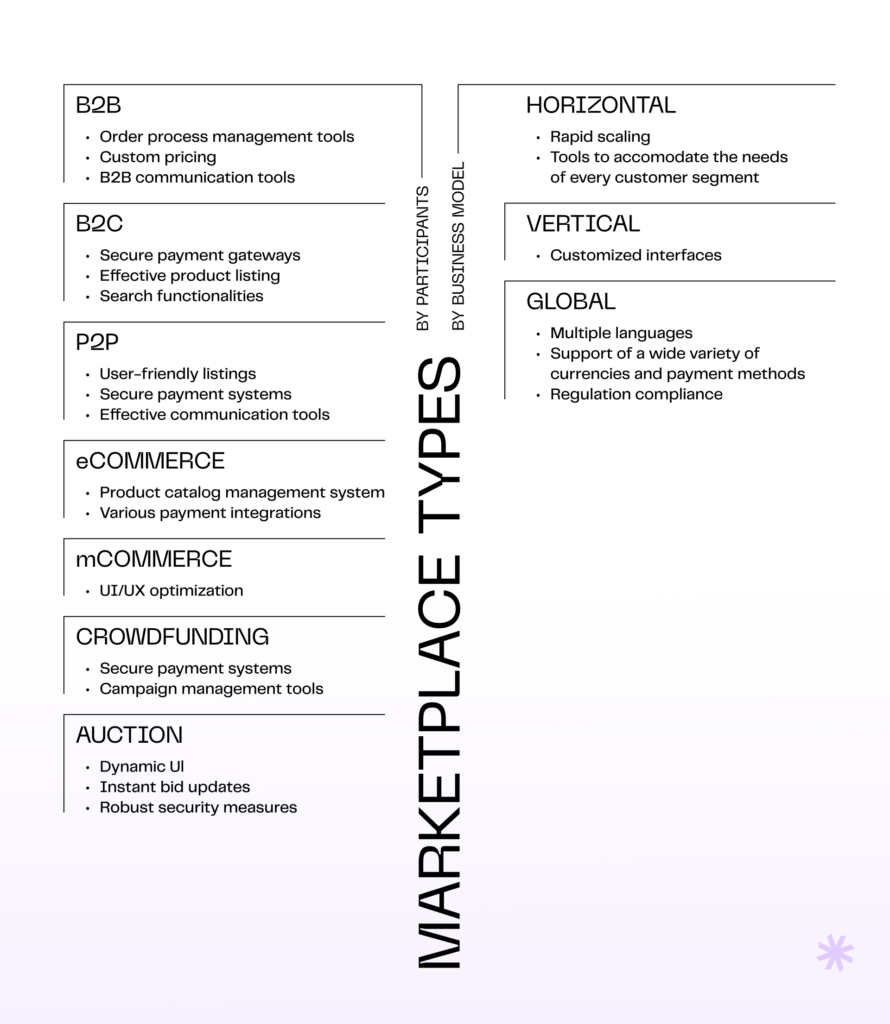
Project scope
A project scope outlines the things the project will deliver. It includes the features, functionalities, deliverables, and constraints. Properly defining scope is crucial for managing expectations, resource allocation, and setting clear objectives.
The process of defining scope includes:
- Gathering requirements from stakeholders and C-level;
- Breaking down objectives into smaller, manageable tasks or user stories;
- Estimating human and technological resources for each task;
- Estimating time for each task, considering dependencies;
- Identifying and assessing risks;
- Planning for contingencies in case of unforeseen issues or changes.
All this information is used to estimate how much it will cost to build a marketplace website, too.
Tech stack for online marketplace development
When considering how much it costs to build a marketplace website, it’s essential to select the right tools, known as tech stack. This choice significantly influences the development cost of a marketplace website since different frameworks and libraries vary in their ability to expedite the developer’s work.
Our guide on selecting the right tech stack offers a detailed description of various technologies. We also provide examples of projects that benefit most from specific stacks. Here, we’ll highlight key information about the popular technologies used in custom marketplace development in the table below.
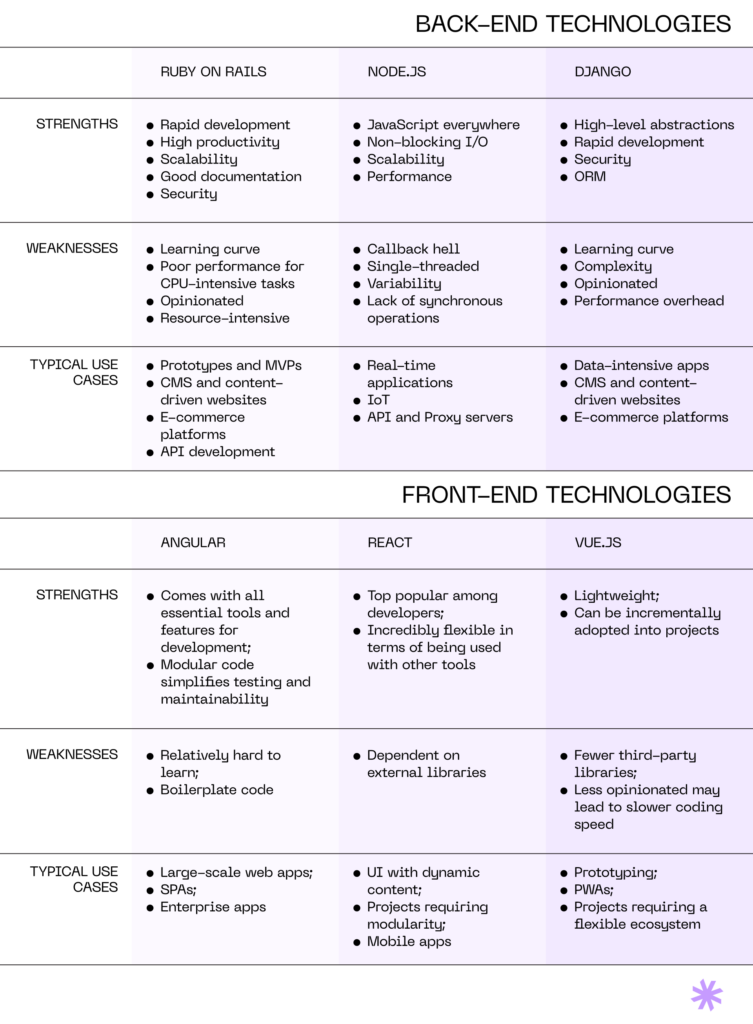
Consider these tips to reduce the cost of developing an online platform:
- Use open-source technologies like Django (Python), Ruby on Rails (Ruby), and Laravel (PHP), which come without licensing fees;
- Opt for cloud platforms (e.g., AWS, Azure, Google Cloud) to minimize infrastructure costs;
- Choose widely-used frontend frameworks such as React or Vue.js and utilize UI component libraries to accelerate development;
- Implement microservices for independent scaling and to minimize the financial impact of changes;
- Consider outsourcing development to leverage cost differentials;
- Begin by creating a Minimum Viable Product (MVP) to test the market before making substantial investments.
Read also: The business benefits of hiring a dedicated development team
Design of the marketplace platform
The cost of designing an online marketplace can be influenced by factors like complexity, project scope, and the number of screens targeted. The greater the number of features and the complexity of the UI in your marketplace, the more time the designer will need, resulting in higher costs.
Likewise, a clear vision from stakeholders reduces the need for experimentation and cuts down the hours spent on design.
To minimize design costs:
- Conduct research on other marketplaces in your niche, noting likes and dislikes.
- Clearly define the project scope to save time and money.
- Get quotes from different designers, considering their experience, work samples, and project estimates.
For reference, here’s a comparison of web designer salaries across Europe and the USA based on Glassdoor data.
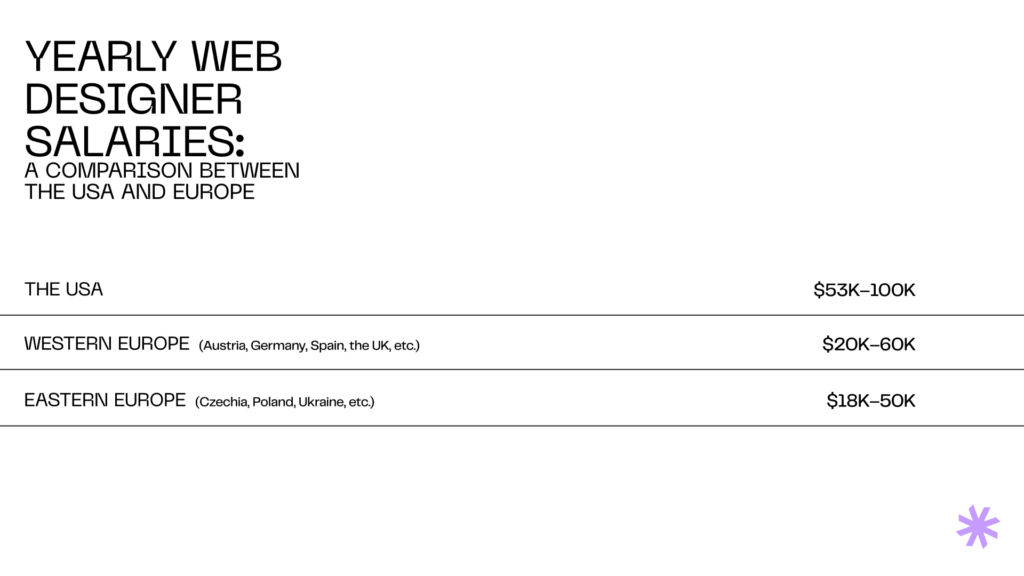
Project management approach
The framework used for your software development project greatly affects how much it costs to build a marketplace website.
A framework helps in planning, executing, and controlling the development process. Therefore, it’s important to pick a project management approach that aligns with your project’s needs.
There are two widely used project management approaches:
- Waterfall model
- Agile methodology
In our guide to the software development process, we discuss these and other approaches in more detail. Now, let’s briefly compare the Waterfall model and Agile methodology and identify the types of projects each is best suited for.
| Criteria | Waterfall | Agile |
| Process | Linear and sequential | Iterative and flexible |
| Project planning | Comprehensive upfront planning | Adaptive planning |
| Flexibility and adaptability | Limited | High |
| Client involvement | Limited until final delivery | Continuous and regular |
| Testing | At the end of development | Throughout the development |
| Risk management | Low flexibility to handle risks | Embraces change, mitigates risks |
| Projects suited for | Small to medium-sized projects with well-defined and stable requirements | Projects with evolving or uncertain requirements |
Engagement model
Various engagement models use different methods to estimate, manage, and pay costs. It’s crucial to understand these models and choose the most suitable one for your marketplace project.
Consider factors like complexity, requirement stability, urgency, risks, and your readiness to participate in the development process as a client.
The two most popular engagement models for marketplace development are:
- Time & Materials model
- Dedicated development team (DDT)
Now, let’s briefly compare these models.
| Criteria | Time & Materials | DDT |
|---|---|---|
| Billing | Based on actual time spent and resources used | Monthly payment for a dedicated team of specialists |
| Cost predictability | Variable costs, potential for uncertainty | More predictable and stable costs |
| Flexibility for changes | Highly flexible, accommodates changes easily | Moderate flexibility, can adapt to changes but within scope |
| Client’s involvement | Regular involvement in project decisions | Direct management and involvement in team tasks |
| Risk distribution | Shared risk between the client and the provider | Shared risk, with the provider handling operational risks |
| Best suited for | Research and development projects; Prototyping and exploration phases; Projects with evolving or unclear requirements; Projects where scope may change frequently | Ongoing software development and maintenance; Large-scale projects with long-term commitments; Projects requiring consistent team expertise; Continuous product development and improvements; Projects with dynamic and evolving requirements |
Customization
The uniqueness level is another crucial factor affecting how much it costs to build a marketplace website.
There are various pre-made marketplace solutions in the market with basic functionality, offering light customization for additional features and appearance. Examples include Magento, Shopify, and Sharetribe. Their advantage lies in quick release to end-users, minimizing development costs.
Custom development, on the other hand, demands a significant upfront investment but provides freedom in choosing desired functionality without restrictions. To save costs, a hybrid approach is often used as it combines pre-built solutions for common functions and custom development for unique or critical components.
To decide between a pre-made platform with customization or fully custom development, follow these steps:
- Assess if the off-the-shelf solution aligns with your business’s core needs;
- Evaluate unique marketplace requirements and their significance;
- Consider budget, timeline, and long-term project vision;
- Examine the impact of ongoing subscription costs on long-term budgets;
- Evaluate the customization capabilities of the chosen off-the-shelf solution;
- Weigh the benefits of full control and customization against higher upfront costs.
For a general understanding of the benefits and drawbacks of off-the-shelf software versus custom development from scratch, refer to the comparison table.
| Criteria | Off-the-shelf software | Custom development |
|---|---|---|
| Initial cost | Lower upfront costs due to shared development and maintenance | Higher initial costs as the entire solution is built from scratch |
| Time-to-market | Faster implementation with pre-built functionalities | Longer time-to-market |
| Maintenance and updates | Vendor handles maintenance and updates, but ongoing subscription costs | Full control over maintenance, updates, and associated costs |
| Scalability | May have limitations in scalability based on the original design | Highly scalable, tailored to specific scalability and growth needs |
| Unique features | Limited to features provided by pre-made solution | Ability to implement unique features and functionalities specific to the marketplace |
| Integration | May require additional effort to integrate with existing systems | Seamless integration with existing systems and technologies |
| Vendor dependency | Dependent on the vendor’s product roadmap and support policies | Independence from vendor decisions and policies |
| Long-term cost considerations | Ongoing subscription costs may accumulate over time | Higher upfront costs but potential for lower long-term costs based on ownership |
| Best-suited for | Standard marketplace functionalities; Quick deployment and budget constraints; Projects with straightforward requirements | Unique or highly specialized marketplace requirements; Long-term vision and strategic marketplace goals; Projects with high complexity and scalability needs |
Read also: Low-code development: is it time to fire your engineering team?
Ready to build your own marketplace?
Reach us with your idea to receive an estimated quote
Contact usThe cost of building an MVP in a marketplace project
It’s generally advised to begin by launching an MVP for your marketplace. This allows you to test the audience’s response and start generating profits quickly. Over time, you can then enhance and expand the existing functionality to create a comprehensive and unique product.
But how much does it cost to build a marketplace app MVP? Since an MVP typically includes only basic marketplace functionality, the average custom marketplace app cost usually ranges from $100,000 to $125,000, generally not exceeding the $200,000 threshold.
The factors influencing the cost of creating an online marketplace MVP are similar to those in a full-scale project. The key challenge is to accurately define and prioritize the core features. To assist you, here is a list of common functionality found in a marketplace MVP.
Core features of an online marketplace MVP
1. Registration and sign-in
To get started on your platform, newcomers need a way to register, while registered users can list products or services. The simplest method is manual input of email and password with email confirmation.
Alternatively, you can opt for multi-factor identification or simplify registration with social logins via Google and other platforms.

2. Profiles
Users provide necessary information in their profiles, such as a seller’s business name, product listings, or buyer’s details. Adding personalization options, like profile photos, a bio section, or design customization, facilitates trust but also influences the marketplace development cost.
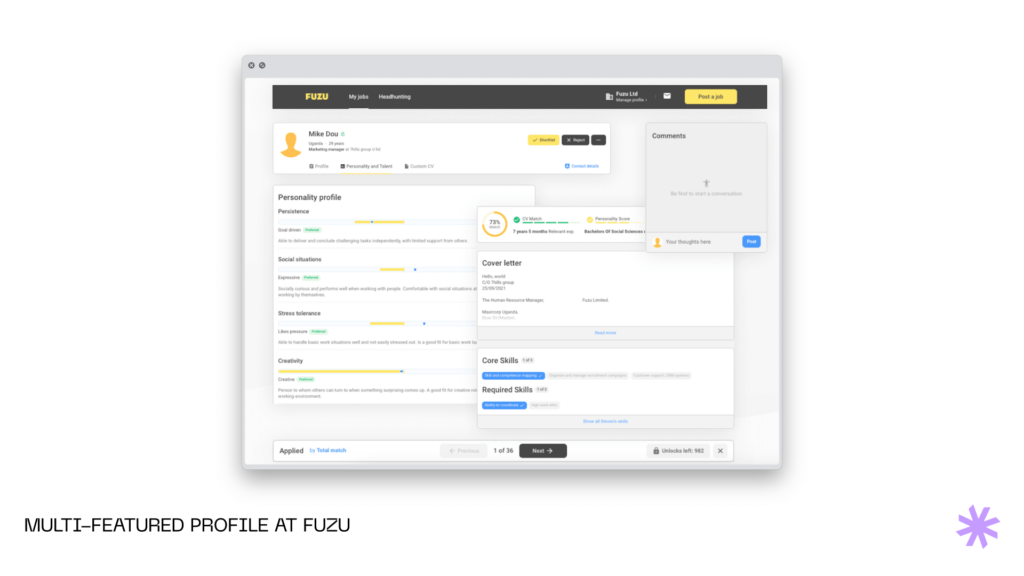
3. Item listing
This is a virtual storefront where sellers list products. It may be a classic image and text duo, or you can explore options like video uploads, changing listing views, breadcrumbs for navigation, and social sharing buttons. The added complexity equally contributes to user experience and the overall marketplace app cost.
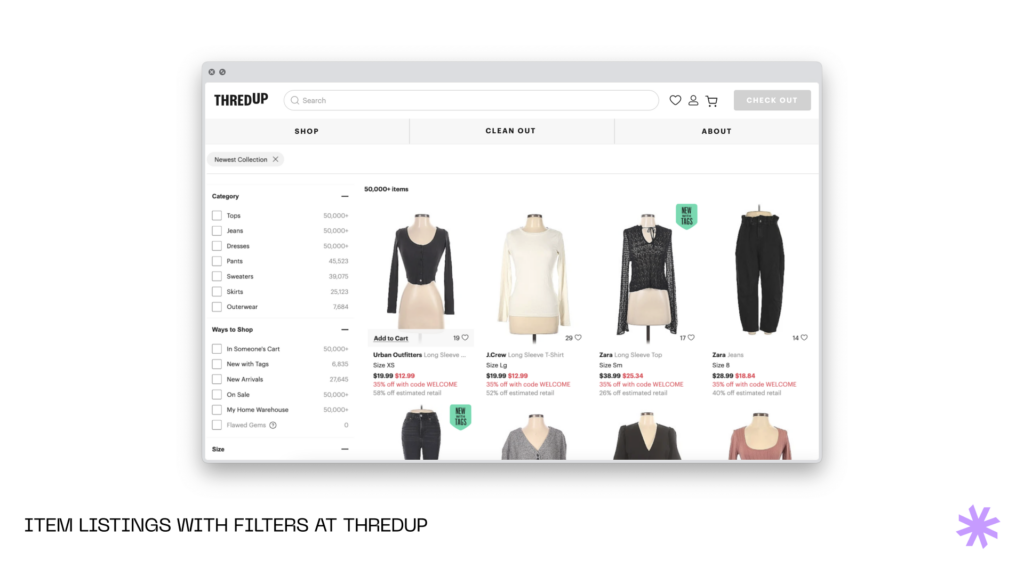
4. Search
Facilitates navigation through item listings with filters. The search field’s intelligence and complexity options range from a basic text field to autocomplete suggestions and faceted search software, all affecting the marketplace app development cost.
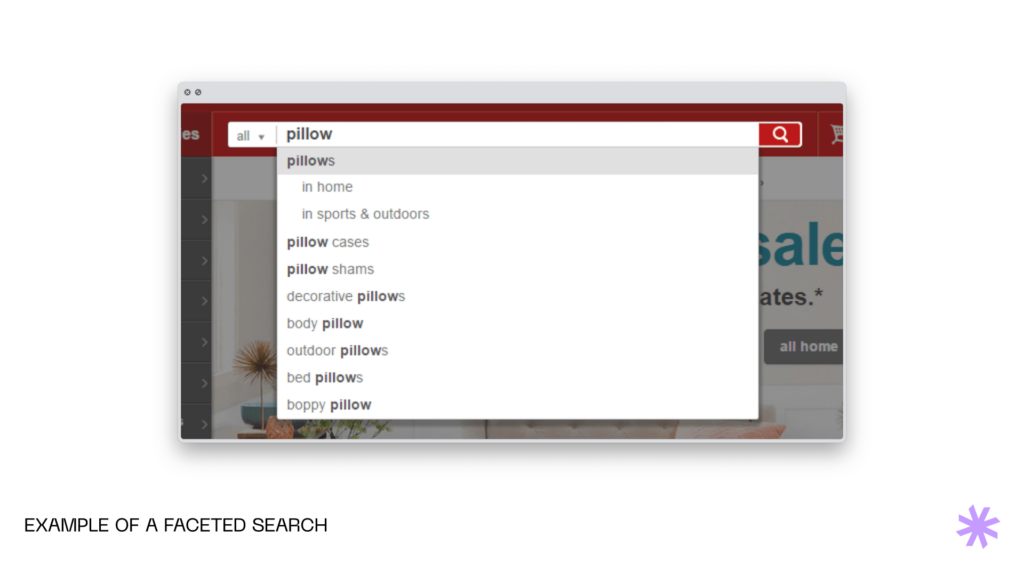
5. Product page
Displays detailed information about a product. As you build a marketplace app, you may choose to add features like videos, GIFs, 3D models, customer reviews, live chat, or related products. This enhances customer engagement but increases the marketplace app cost.
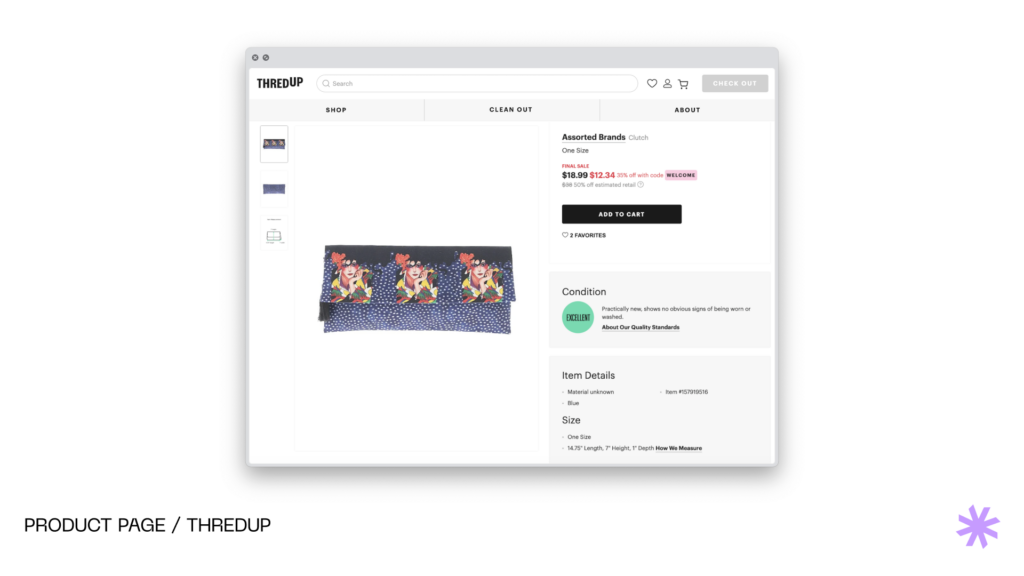
6. Shopping cart
Holds chosen but unpurchased items. The cart’s functionality, whether mini or full page, single-page checkout or step-by-step, and the availability of help elements or live support impact the e-commerce app development cost.
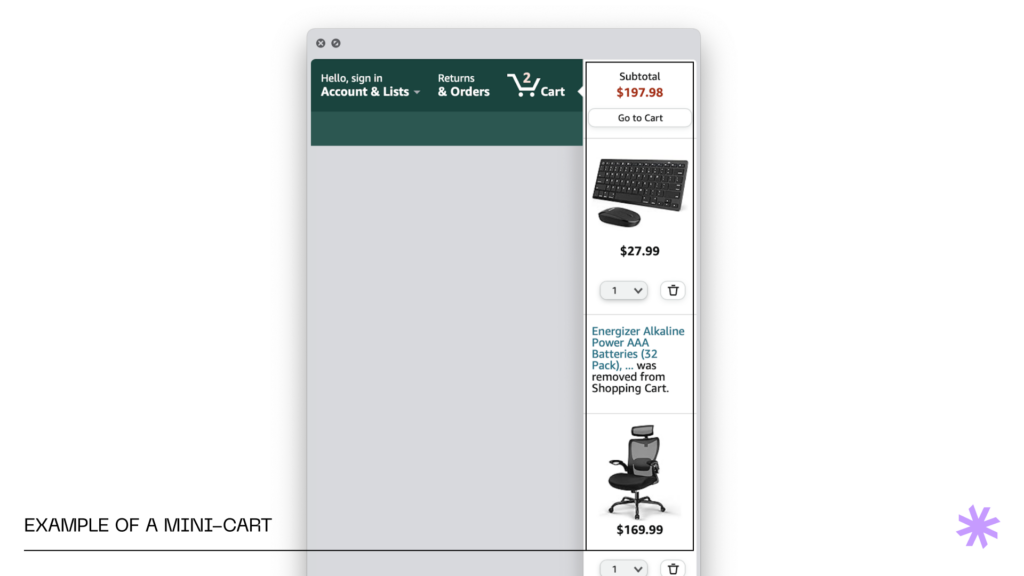
7. Payment
Allows buyers to choose payment options and payment gateways and add card information. Integrating various payment methods like PayPal, Google Pay, and others adds to the development cost.
8. Administrator panel
Necessary for business owners to customize settings and policies and manage content. You can control the marketplace app cost by regulating how much an admin can do in this section.
For instance, an admin panel may be just a place to manage content and moderate users or additionally provide statistics.
9. Shipping
Enables buyers to review and choose delivery options. Shipping integration options, such as real-time carrier rates or local delivery with geolocation features, contribute to the overall marketplace app development cost.
Killer features of a marketplace app
While core features ensure basic functionality, standing out from the competition is crucial, even in an MVP. And that’s one more thing to factor in when considering how much it costs to develop a marketplace app.
Here are some ideas:
- AR technology
AR is the trending feature that lets customers evaluate the item’s look before purchase. The feature is viral among furniture manufacturers, suppliers, and retailers. However, it can substantially increase the marketplace app cost.
- Voice search
More than 30% of internet users performed a voice search. This feature hasn’t been disseminated through marketplaces yet, so you can use it to get ahead in the competition.
- Ratings and reviews
Including review functionality provides buyers insights into product or service quality, fostering trust. Ratings help position sellers on your marketplace platform strategically.
- Wish List
Allows buyers to save products they are considering. Enabling wish list sharing boosts engagement, drives more traffic, and provides valuable user data, though it increases the marketplace app cost.
- Messaging
This is where sellers and buyers discuss products, services, and related information. The chat may allow media file exchange and offer pre-made templates for more efficient communication.
How much does it cost to develop a marketplace app? A sample estimate
The question “How much does it cost to build a marketplace website like Amazon?” is commonly searched on Google. While the exact cost of Amazon’s software isn’t publicly available, we can provide an estimate for building a marketplace website with basic functions.
Let’s break down the functional aspects of a B2C horizontal marketplace where customers can find various products. Note that this breakdown excludes additional features to the original Amazon website, such as Amazon Prime, Echo and Alexa integration, etc.
| Function | Sub-function |
|---|---|
| Guest visitor authorization & authentification | Registration by phone |
| Phone verification | |
| Log in via phone | |
| Forgot password | |
| Privacy Policy and Terms & Conditions | |
| Home page | Header, banner & footer |
| List of latest ads for selected/default location | |
| View categories | |
| FAQ/About | |
| Search/Browse ads | Search by keyword |
| Search results: list of ads matching search query | |
| Filters | General filters (price, category, location) |
| Ad details page | View ad images |
| Display the list of recommended ads | |
| View ad information | |
| Authorized user authorization & authentification | Log out |
| Ad details page | Show contact |
| Report an ad | |
| Number of views count | |
| Settings | Edit profile |
| Change language | |
| Delete profile | |
| Change password | |
| Balance | View balance |
| Recharge balance | |
| View transaction history | |
| Ad management | View list of ads |
| Close ad | |
| Create/edit an ad | Fill in general information when creating an ad |
| Upload images when creating an ad | |
| Edit an ad | |
| Prioritize an ad | “How it works” page |
| Approach 1: search results list of premium ads matching search query | |
| Aproach 2: Raise the ad to the top of the list | |
| Select a prioritization approach | |
| Notifications | Notification set up |
| Ad is waiting for payment (deep link to an ad) | |
| Ad was edited by admin | |
| Successful payment (for a new ad) | |
| Admin authorization & authentification | Log in |
| Log out | |
| Manage admins | CRUD |
| Manage categories | CRUD |
| Manage locations | CRUD |
| Ad management | View list of reported ads and reasons |
| View list of ads pending review | |
| Create/edit an ad | |
| Delete an ad | |
| Close an ad and Autoclosing after X time | |
| Approve an ad | |
| Decline an ad and specify the reason | |
| Sort ads by status | |
| Payment management | View the list of balance charges pending confirmation |
| View the list of reviewed ads pending payment confirmation | |
| Confirm payment received for an ad | |
| Confirm payment received for ad prioritization | |
| View list of prioritizations pending payment confirmation | |
| Confirm payment received for a balance charge | |
| Basic analytics | View the total amount of money earned |
We’ve identified the essential system functions and divided them into sub-functions that can be developed and tested separately. Now, we can work with the development team to estimate the time required for implementation.
Our project also contains non-functional requirements, such as localization, since the platform will be in two languages.
Additionally, we have to factor in time for architecture design, UI/UX concepts, project setup, and database creation.
Given that software development is a creative process, we must also allocate time to discuss different solution options with stakeholders.
As a result, the answer to the question of how much it costs to build our marketplace website is as follows.
| Normal scenario, h | Worst-case scenario, h | Rate/hour, USD (varies based on the specialist level) | Total, USD | |
| Business analysis | 420 | 504 | 35-70 | 14,700-29,400 |
| Design | 212 | 360 | 35-70 | 7,420-25,200 |
| Project management | 336 | 504 | 35-70 | 11,760-35,280 |
| Back-end engineering | 587.75 | 783 | 45-90 | 26,449-70,470 |
| Front-end development | 479.50 | 652 | 45-90 | 21,578-58,680 |
| Quality assurance | 462 | 756 | 35-70 | 16,170-52,920 |
| Total | 2,497.25 | 3,559 | 98,077-271,950 |
And that’s the estimate for developing a basic B2C marketplace—considering time and cost. Note that it’s a simplified version, meeting minimum usability standards. For a more complex, feature-rich marketplace, costs will be higher.
Strategy to save marketplace development costs
Now, with the main cost factors for a marketplace project in mind, you can outline the key points to achieve cost-efficiency. Let’s briefly summarize them:
- Define clear requirements. Knowing what and how exactly you want to build and documenting the requirements reduces the likelihood of scope creep and changes during the development process, which can add to costs.
- Prioritize features. If you opt for MVP development, focus on core functionalities that directly contribute to the marketplace’s primary objectives. Additional features can be added in later phases.
- Use open-source solutions whenever possible. This can significantly reduce marketplace development costs by eliminating the need to build certain components from scratch.
- Outsource the development. Consider utilizing developers in regions with lower labor costs. However, ensure that there is effective communication and project management to mitigate potential challenges.
How do marketplaces make money?
A marketplace is both an investment and a potential money-spinner. The key is picking the right way to make money. Check out the table below, which lists common monetization models and the platform types they suit best.
| Monetization model | Description | Best for | Example |
|---|---|---|---|
| Transaction fees | Charges a percentage or flat fee per transaction between buyers and sellers | E-commerce platforms Service marketplaces Freelance platforms Ticketing platforms | Etsy |
| Subscription fees | Charges users a recurring fee for access to premium features, services, or content | Membership-based platforms Content subscription platforms Software as a Service (SaaS) platforms | LinkedIn Premium |
| Listing fees | Charges sellers a fee to list their products or services on the platform | Classified ad platforms Real estate marketplaces Job boards | Airbnb |
| Advertising revenue | Generates revenue through display ads, sponsored listings, or promoted content | Social media platforms Content-driven platforms Informational websites | |
| Lead generation fees | Charges service providers for customer leads generated through the platform | Home services marketplaces Professional services platforms B2B marketplaces | Thumbtack |
| Affiliate marketing | Earns a commission for sales or leads generated through affiliate links on the platform | Product review platforms Comparison shopping websites Affiliate marketing platforms | Amazon Associates |
| Rental fees | Charges users for renting products or services listed on the platform | Equipment rental platforms Vacation rental marketplaces Car rental platforms | Turo |
How can Syndicode help build an online marketplace and keep costs at bay?
Syndicode has substantial experience turning ideas into profitable marketplaces. Our custom development framework minimizes the marketplace website development cost and allows scalability. We prioritize careful planning, transparent communication, smart technology choices, and rigorous quality control. Our ideas have proven very effective for our clients.
For instance, Hlprs is a platform for hiring house servicemen that our team has worked on. Our professionals created a 100% automated marketplace, reducing manual work significantly. Thanks to our use of heavy-weight technologies, the company’s order flow increased by 1000%, and processing became three times faster.
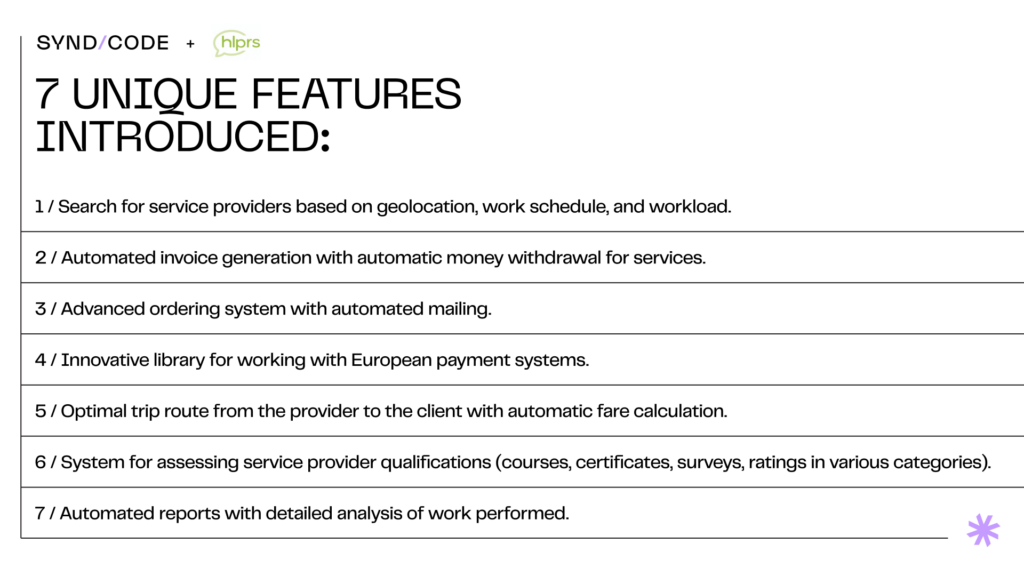
We’ve also partnered with Fuzu, a well-known African startup. We implemented top-notch Finnish practices for website functionality, helping Fuzu attract 70,000 unique users within a year. It’s now the leading job offers provider in East Africa.
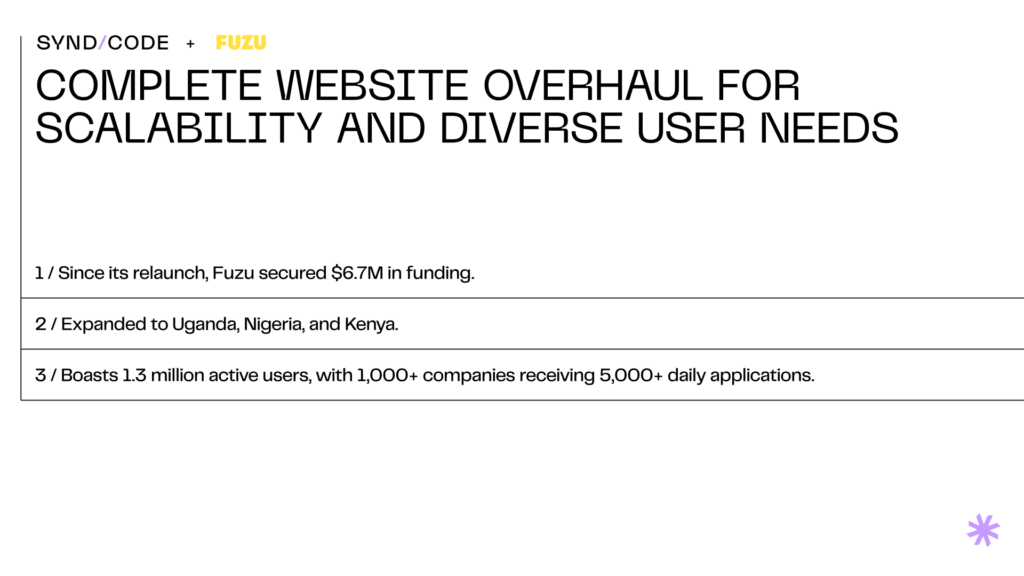
Another success story is Movinga, a relocation service. We provided full-stack development services, including web app architecture, adaptive UX/UI design, and API back-end. With Syndicode, the company launched its MVP from scratch in just 9 months. Our automation solution slashed customer support costs by 93%. Eventually, Movinga exited for €15 million.
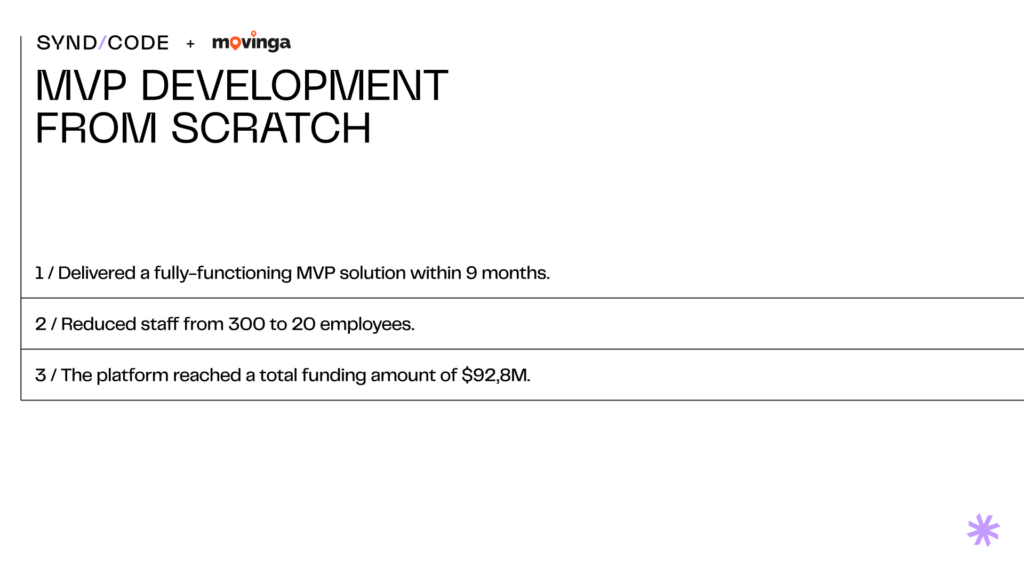
Want a custom revenue-bringing marketplace?
Contact us to discuss your idea and come up with a unique solution
Contact usSummary: how much does it cost to build a marketplace website?
Generally, the answer to the question, “How much does it cost to build a marketplace website?” can be as follows. The marketplace website development cost depends on the industry, target audience, and type of marketplace.
From our experience, custom marketplace development cost typically ranges from $100K to $350K. Larger, ongoing projects with advanced features may exceed this range.
While this article offers a general overview of factors to consider and things to accomplish to reduce development costs, it’s important to understand that specific niches and teams have unique risk factors.
Therefore, it’s crucial to collaborate with your development services provider to outline the project scope and create a budget estimate. They know their people’s strengths and the best project management approach.
If you have any questions about custom software development services, the Syndicode team is here to help. Check our featured cases page and client reviews for insights into our expertise in building automated marketplace systems, optimizing investments, and expanding business reach.
Frequently asked questions
-
How to create an online marketplace website?
The answer to how to create a marketplace website is simple. There are five basic steps: 1. Come up with an idea and validate it. A viable marketplace idea should solve a problem for both the customer and the seller. At Syndicode, we always start with business analysis to understand current issues in the industry and identify the potential. 2. Decide on your marketplace type and business model. Knowing the right type will help you define the potential buyer base, choose the most appropriate monetization strategies, and avoid extra investments in the website and app development for a marketplace. 3. Determine the functionality of your future marketplace. Depending on your goals and budget, you can go with the minimal set of features or expand them to maximize your competitiveness. Remember that the chosen functionality set defines the final marketplace website development cost. 4. Choose a tech team to implement your project. A wise choice results in higher marketplace website quality, less need for maintenance, shortened time to market, and reduced costs. 5. Launch your marketplace and start achieving your business goals. To ensure the successful launch of your new online marketplace, you should test it to eliminate any chance of malfunction. Don’t forget about marketing to encourage user flow from the very first days.
-
How quickly will the marketplace be сreated?
The times for custom marketplace development vary. Depending on the marketplace type, business model, and features, creating a marketplace website from scratch may take four to six months. In the case of a complex marketplace platform like Amazon, the web development process may take twelve months or more. This time involves information collection, business analysis, planning, design and prototyping, coding, and testing. At Syndicode, we start by presenting the methodology and work processes chosen for your project. This ensures everyone is clear about deliverables and the estimated development time frame.
-
How much will it cost to create your own custom marketplace?
To answer the question, “How much does it cost to build a marketplace website?”, we need to know the desired complexity of the platform and your tech partner’s location. Thus, if outsourcing your marketplace building to a team from Eastern Europe, the estimated marketplace website development cost varies between $80K–$289K for a fully featured product. The cost of developing a marketplace website increases if done by engineers from Western Europe: expect to pay around $130K–$570K for a simple solution. US developers will charge between $240K–$820K since their rate is three times as high as one of the Ukrainian software companies. If you’re curious how much it costs to develop a marketplace app, the price tag for this depends on the app’s functionality. Again, depending on where your software developers are located, marketplace app development costs for a simple solution can go from $80K to $280K and more.
-
Why choose Syndicode for building a custom marketplace?
Syndicode is a software development company specializing in building custom marketplaces from scratch. We do a full-cycle development, from brand identity to design and development to the fully featured product and its maintenance. The accumulated experience allows us to approach each new project with a clear plan and established processes. We believe that effective communication is the pillar of quality marketplace development. Therefore, we hold a discovery session at the beginning of the work to collect all the information about your industry, business, and vision. Next, we perform business analysis to assist you with ideas that best fit the current market. By 2022, we have created over 140 successful solutions. Many of our marketplace projects have paid off six months after launch. After working with us, our clients have increased their revenue flow, removed handicaps for business growth, and started providing an enhanced UX to their customers.
-
How is the cost determined in marketplace development projects?
To determine how much it costs to develop a marketplace app, one should consider a variety of interconnected factors, including the scope, complexity, features, technology stack, and other considerations. For instance, complex features, such as real-time chat, payment processing, search algorithms, and third-party integrations, can increase marketplace development costs as they require more time to build and set up. They might also require more intricate design, requiring additional development effort and thus increasing costs. The choice of features also affects the choice technology stack, which, together with the chosen platform on which the marketplace is built (web, mobile, or both), can impact costs. To get an accurate estimate, it’s advisable to work closely with a development team or agency, provide detailed project requirements, and consider conducting a feasibility study or discovery phase. This allows for a thorough understanding of the project’s complexities and a more accurate estimation of development costs.
-
Are there any hidden costs in marketplace development that I should be aware of?
Yes, there can be hidden costs associated with marketplace development. Some potential hidden costs include changes to the initial project requirements, as they often lead to scope changes, thus affecting the final cost. Data migration is another frequent line of expenditure as it can be more complex and time-consuming than anticipated, leading to additional costs. User training and onboarding may become necessary if the marketplace involves a complex interface or unique workflows, so you’ll need to budget for that, too. After the marketplace is live, there may be additional costs associated with marketing and promotion to attract users and build awareness. To mitigate the risk of hidden costs, it’s essential to conduct thorough planning, clearly define project requirements, and work closely with your development team or agency to account for potential challenges and changes.
-
What is the cost of developing a mobile application alongside a web-based platform?
We have an article in this blog dedicated to calculating the cost of a mobile development project named How Much Does It Cost to Build an App? In short, the average cost for custom mobile app development varies between $50K–300K for a small to medium-sized solution. Just like with a website, to estimate how much it costs to develop a marketplace app, you should consider scope and features, design complexity, platform choice, technology stack, project management, and scalability requirements.
